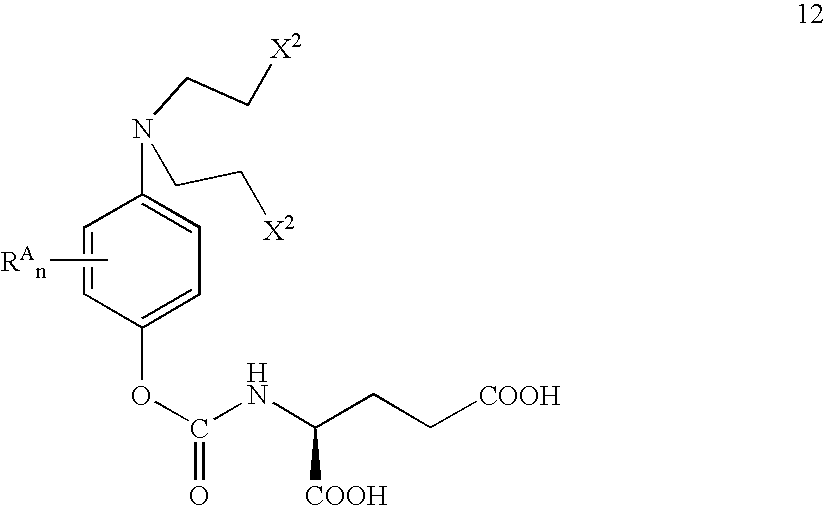Methods of chemical systhesis of phenolic nitrogen mustard prodrugs
a technology of phenolic nitrogen mustard and chemical synthesis, which is applied in the field of organic chemical synthesis, can solve the problems of low yield and low yield reaction
- Summary
- Abstract
- Description
- Claims
- Application Information
AI Technical Summary
Benefits of technology
Problems solved by technology
Method used
Image
Examples
example 1
4-Benzyloxy-N,N-bis(2-hydroxyethyl)aniline (2A)
[0458]
[0459]4-Benzyloxyaniline hydrochloride 1A (9.32 g, 39.5 mmol) was dissolved in acetic acid (400 mL), triethylamine (6 mL, 43 mmol) was added followed by ethylene oxide (20 mL). The reaction mixture was stirred at room temperature for 72 h, the solvent was evaporated in a rotary evaporator under water pump then under oil pump at 50° C. for 1 h. The residue was then diluted with water (500 mL) and the precipitate recovered by filtration, washed with more water, then dried in dessicator over P2O5 to afford 2A (9.6 g, 84%) as a pale brown powder.
[0460]1H-NMR (DMSO-d6) δH: 3.32 (t, 4H, N(CH2CH2OH)2), 3.42-3.52 (m, 4H, N(CH2CH2OH)2), 4.65 (t, 2H, OH, J=5.90 Hz), 4.97 (s, 2H, PhCH2), 6.60 (d, 2H,) Harom3+5, J=9.10 Hz), 6.83 (d, 2H, Harom2+6), 7.25-7.44 (m, 5H, Harombenzyl)
example 2
4-Benzyloxy-N,N-bis[2-(t-butyldimethylsilyloxy)ethyl]aniline (3A)
[0461]
[0462]A mixture of 2A (9.6 g, 33.4 mmol), t-butyldimethylsilyl chloride (12.7 g, 84 mmol) and imidazole (7.8 g, 130 mmol) were dissolved in dry DMF (80 mL) and the reaction stirred overnight, then the solvent was evaporated, the residue taken in dichloromethane, the precipitated imidazole hydrochloride filtered off, and the filtrate evaporated. The residue was purified by column chromatography on silica (cyclohexane:ethyl acetate 4:1), to afford 3A (16.4 g, 95%) as an oil.
[0463]1H-NMR (DMSO-d6) δH: −0.01 (s, 12H, 2×SiMe2), 0.84 (s, 18H, 2×Sit-Bu), 3.39 (t, 4H, N(CH2CH2OSi)2, J=5.98 Hz), 3.67 (t, 4H, N(CH2CH2OSi)2), 4.96 (s, 2H, PhCH2), 6.59 (d, 2H, Harom3+5, J=9.03 Hz), 6.82 (d, 2H, Harom2+6), 7.25-7.44 (m, 5H, Harom benzyl).
example 3
4-{N,N-bis[2-(t-butyldimethylsilyloxy)ethyl]amino}-phenol (4A)
[0464]
[0465]The benzyl ether 3A (11.4 g, 22.1 mmol) was dissolved in THF, Pd / C catalyst (1.6 g) was added and the suspension stirred overnight under H2 atmosphere. The catalyst was filtered off, the solvent evaporated to afford 4A (9.4 g, 100%) as an oil.
[0466]1H-NMR (DMSO-d6) δH: 0.00 (s, 12H, SiMe2), 0.84 (s, 18H, Sit-Bu), 3.34 (t, 4H, N(CH2CH2OSi)2, J=6.07 Hz), 3.65 (t, 4H, N(CH2CH2OSi)2), 6.51 (d, 2H, Harom2+6, J=9.23 Hz), 6.58 (d, 2H, Harom3+5), 8.46 (s, 1H. OH).
PUM
| Property | Measurement | Unit |
|---|---|---|
| temperature | aaaaa | aaaaa |
| temperature | aaaaa | aaaaa |
| reaction time | aaaaa | aaaaa |
Abstract
Description
Claims
Application Information
 Login to View More
Login to View More - R&D
- Intellectual Property
- Life Sciences
- Materials
- Tech Scout
- Unparalleled Data Quality
- Higher Quality Content
- 60% Fewer Hallucinations
Browse by: Latest US Patents, China's latest patents, Technical Efficacy Thesaurus, Application Domain, Technology Topic, Popular Technical Reports.
© 2025 PatSnap. All rights reserved.Legal|Privacy policy|Modern Slavery Act Transparency Statement|Sitemap|About US| Contact US: help@patsnap.com



